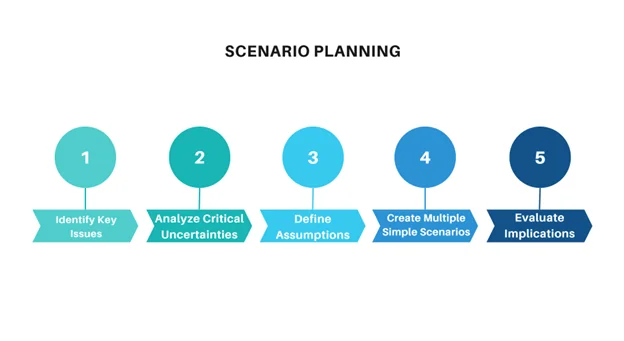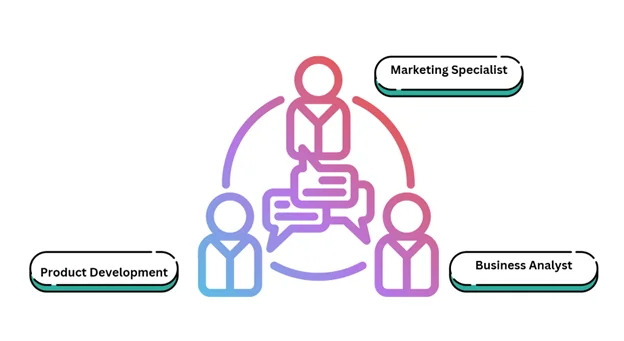The COVID-19 pandemic showed how fragile even the best-laid plans can be. For tech companies that thrive on innovation and adaptability, anticipating and navigating uncertainties is crucial. This is where scenario planning shines.
It’s a strategic tool that generates and analyzes multiple plausible futures. Moreover, it helps tech companies develop flexible strategies to thrive in an ever-changing world.
In this article, we’ll examine scenario planning’s benefits and limitations and discuss how to integrate it into your strategies.
- Definition of Scenario Planning
- Exploring Different Types of Scenario Planning
- How Scenario Planning Works
- How to Implement Scenario Planning in Tech Firms
- Advantages & Challenges Scenario Planning for Tech Companies
- Best Practices for Scenario Planning and Analysis
- Common Pitfalls in Scenario Planning to Avoid
- Harnessing Scenario Planning to Transform Your Tech Business
What is Scenario Planning?
Scenario planning, or scenario forecasting, is a strategy where businesses explore several future outcomes to prepare accordingly. They imagine various “what-if” scenarios to find weaknesses or evaluate new projects.
Unlike traditional methods that rely heavily on past data, scenario forecasting involves subjective opinions and assumptions. Traditional models often fall short due to their linear projections. Scenario planning, on the other hand, offers more realistic forecasts by considering a range of possibilities.
It was conceived in war rooms during the Second World War. Since then, it has found its way into board rooms. A notable beneficiary is Shell, which used the strategy to power through the 1970s oil crisis.
Importance of Scenario Planning for Tech Companies
The tech industry is marked by rapid innovation. Companies that stick rigidly to one vision often get blindsided by unexpected events. What compounds the issue further is the fact that consumer needs change and competitors emerge quickly.
Scenario planning encourages tech firms to embrace change and experiment with different strategies. They can anticipate different futures, from disruptive technological breakthroughs to regulatory changes. This allows them to pivot or seize new opportunities swiftly. It also helps them address the ethical and social implications of their work.
Scenario Planning vs. Business Continuity Planning
These two are frequently interchanged. They do, however, have key distinctions.
Scenario planning is mainly proactive and focuses on the future. It involves developing and evaluating scenarios with an emphasis on long-term business revenue.
In contrast, business continuity planning is both proactive and reactive. This strategy outlines technical and administrative procedures to manage disasters in the short term.
Together, they ensure your business is resilient and adaptable in uncertain times.
Types of Scenario Planning
Scenario planning can be divided into four primary types. Organizations typically achieve the best results by using a combination.
-
Quantitative Scenarios
Quantitative scenarios use numerical data and statistics to project future outcomes. Tech companies use these to forecast:
- Future market trends
- Sales
- Revenue
This can influence decisions on investments and other expenditures. These scenarios can also assess different risks, helping companies prepare for economic downturns, data breaches, and other operational threats.
-
Operational Scenarios
Operational scenarios describe specific processes and actions and explore their subsequent outcomes. They are used to analyze and plan daily operations and contingencies for various situations.
Operational scenarios can help companies identify inefficient areas in their workflows. Companies can also prepare for and make adjustments to address unexpected events, such as:
- System outages
- Disruptions in the supply chain
- Cybersecurity attacks or leaks
-
Normative Scenarios
Normative scenarios are future-oriented visions of how a company ideally wants to operate. They encapsulate a set of values, goals, and objectives that serve as guiding principles for decision-making and strategic planning. Decisions are then evaluated based on their alignment with the company’s core principles and long-term vision.
-
Strategic Management Scenarios
Strategic management scenarios are hypothetical narratives exploring different future situations a company might face. They take into consideration industry and market trends, regulatory changes, and technological advancements. Changes to these entities can have consequences that extend well into the future. Companies can then make informed decisions about their long-term trajectory by anticipating threats posed by these constantly evolving factors.
How Scenario Planning Works
The process of scenario planning is comprised of the following steps:
-
Determine a Key Issue
First, you need to narrow down your perspective and identify the key issue or challenge your organization needs to address. Here’s how:
- Look at current trends in the market, economy, technology, politics, the law, and society. Identify issues that could potentially affect your organization.
- Gather input from various stakeholders within and outside the organization.
- Look at internal performance data, financial reports, and operational metrics. Identify any patterns or anomalies indicating any issues.
-
Understand Critical Uncertainties
Critical uncertainties are events that are more likely to occur or have a more considerable effect on your business. To understand these uncertainties, consider:
- How trends and market conditions change over time.
- External factors like the economy, competition, and regulations.
- Internal factors like your resources, skills, and ability to adapt.
-
Clearly Define Assumptions
Even with deep market knowledge, you have to make educated guesses about the future based on past trends, research, or expert opinions. These assumptions need to be clearly defined and checked to make sure they’re relevant and fit with your key issue and critical uncertainties:
- Gather data, conduct research, and consult experts to support your assumptions with real-world information.
- Seek input from stakeholders to ensure that assumptions are not biased or limited in scope.
- Test assumptions by considering alternative viewpoints and potential events that could invalidate them.
-
Make Multiple, Simple Scenarios
Next, it’s time to create a set of scenarios simple enough not to overwhelm your team. Here’s how:
- Create 2 to 4 distinct scenarios by combining different assumptions about the most impactful uncertainties.
- Each scenario should tell a cohesive and plausible story about the future of the key issue.
- Consider both optimistic and pessimistic outcomes.
- Ensure the scenarios challenge existing assumptions and stimulate strategic thinking.
-
Understand Implications
The final step is to analyze the potential consequences of each scenario for your business. Ask yourself and your team the following questions:
- What are the potential threats and benefits that each scenario presents?
- How should our company respond to each scenario to maximize opportunities and reduce risks?
- What actions can we take now to prepare for the different possible futures?
This analysis can help you identify vulnerabilities and opportunities and develop plans to address various possible futures.
(Also Read: Technology Planning Can Help Align IT Goals with Business Objectives)
Implementing Scenario Planning in Tech Companies
Here’s how to implement scenario planning in your tech firm:
-
Engaging Stakeholders
They can spot scenarios that may not be visible to you due to your limited experience or tunnel vision. Involving a diverse group in scenario planning gives you access to more extensive knowledge and insights. This can help cover your blind spots.
Consider these tips to maximize their input:
- Determine your core stakeholders.
- Explain the goals of the scenario planning process and how their input can help achieve them.
- Use a variety of channels to accommodate different preferences and availability.
- Create an environment where they feel comfortable sharing and challenging ideas.
- Keep them informed about the progress and the impact of their contributions.
-
Creating a Scenario Planning Team
Next, assemble a cross-functional team with a blend of skills and perspectives. Based on the previous step, select different individuals from varying backgrounds. Identify the subject-matter experts and problem solvers. These team members should:
- Be capable of identifying patterns, connections, and potential future implications.
- Have the creativity to come up with new ideas and challenge conventional thinking.
- Know the competition, customers’ needs, and new technologies.
- Proficient in gathering, interpreting, and using data for developing scenarios.
- Have strong interpersonal skills for effective teamwork.
-
Using Scenario Planning Tools and Software
Specific tools and software can also streamline the process. There are numerous options available, including:
- Mosaic or Anaplan: Robust platforms for scenario modeling, financial planning, data visualization, analysis, and reporting.
- ERP Systems (e.g., SAP, Oracle NetSuite): Provide the core financial and operational data needed for accurate scenario modeling.
- CRM Systems (e.g., Salesforce, HubSpot): Offer insights into customer behavior and sales data.
Benefits of Scenario Planning for Tech Companies
Scenario planning offers numerous benefits for technological companies. Here are some of them:
- It helps tech companies spot potential risks early, such as regulatory changes, shifts in consumer preferences, and technological advancements.
- Pushes decision-makers to challenge their assumptions and biases to consider unexpected outcomes. This leads to better decision-making.
- Enhances a company’s ability to respond to new competitors, product launches, and industry trends.
- Align a company’s plans with its existing strategies, ensuring that decisions support their overall objectives.
- Encourages collaboration, sparks innovative thinking, and reduces resistance to change, making it easier to implement strategic initiatives.
- It provides more accurate forecasting by considering various possibilities that are not limited by historical data.
Challenges of Scenario Planning
Before incorporating it into your business, there are some inherent challenges to scenario planning you need to consider:
- Scenario planning requires significant financial and personnel investments.
- It relies on assumptions about the future, which can be inaccurate or outdated due to their subjective nature and potential for bias.
- It focuses heavily on external factors, causing companies to merely react to events instead of proactively shaping their future.
- Scenario planning cannot predict all events, especially unpredictable “black swan” events that can disrupt even the best plans.
- Many scenarios can sometimes overwhelm decision-makers, causing indecision due to too many options and a lack of clear direction.
- The challenges in scenario planning are constantly changing as the business environment evolves, necessitating an ongoing process of monitoring and adaptation.
Best Practices in Scenario Planning & Analysis
Here are some tips to make the most of your scenario planning:
-
Start with Major Goals
Effective scenario planning depends on a clear understanding of your primary goals. These goals could be:
- Financial, e.g., revenue growth, profitability
- Market-oriented, e.g., market share, brand awareness
- Operational, e.g., efficiency, innovation
A goal-oriented process ensures the scenarios developed are relevant and actionable.
-
Follow Up with the Base Plan
Your company likely has a base operating plan–a set of strategies and tactics designed to achieve your major goals under normal conditions. Scenario planning should complement, not replace, this plan. Conduct a gap analysis between your base plan and each scenario. Identify where your base plan falls short and develop actions to address these gaps, such as adjusting resources, revising marketing strategies, or exploring new partnerships.
-
Build Best and Worst-Case Scenarios
Don’t forget to consider the extremes. Planning for the best and worst cases helps you see all the possibilities and prepare for both opportunities and threats. When modeling such scenarios, consider factors beyond your control. This can unmask risks and prospects previously unnoticed in more conservative scenarios.
-
Create a Flexible Response Strategy
Scenario planning is more about preparing for the future. Therefore, your scenarios should constantly adapt to changing circumstances. Spot early warnings indicating a shift towards a particular scenario. This can include critical metrics, competitor actions, or industry events.
-
Measure the ROI of Scenario Planning
Scenario planning is an investment, so it’s essential to measure its effectiveness. Track how it has influenced your decisions. Were there any positive changes? Measuring your ROI can prevent wastage of valuable time and money and demonstrate its value to stakeholders.
Scenario Planning Issues to Avoid
Scenario planning has its own set of issues to avoid. Starting scenario planning without first identifying key issues results in an unfocused and unproductive process, wasting time and resources. Additionally, focusing solely on immediate concerns misses the true value of scenario planning, which is to anticipate long-term issues that could significantly impact your business in the future.
Creating too many scenarios can lead to information overload, making it difficult to analyze their implications and develop strategies. Striving for perfect scenarios is also counterproductive, as it can cause analysis paralysis and hinder decision-making. Moreover, fixating on a single, desirable scenario can blind you to other possibilities and limit your ability to adapt.
Industry-Specific Scenario Planning Examples
In the software and SaaS industry, scenario planning is invaluable for navigating rapid shifts in customer expectations and technology. For instance, a SaaS company could create scenarios exploring the impact of increased artificial intelligence (AI) adoption in customer service. Through these scenarios, they can proactively develop AI-powered features and stay ahead of the competition.
Healthcare tech companies face unique challenges due to heavy regulation and constantly evolving medical knowledge. Scenario planning helps anticipate changes in healthcare laws or new treatment methods.
The financial technology (fintech) sector is constantly evolving. New technologies like blockchain, digital payments, and robo-advisors are outgunning traditional financial services. Scenario planning can help fintech companies stay ahead of the curve and manage the potential impact of digitization on their businesses.
Unlock the Power of Scenario Planning for Your Tech Business
Again, remember these key steps to integrate scenario planning into your tech business successfully:
- Define key issues.
- Identify critical uncertainties.
- Assemble a cross-functional team.
- Create simple future scenarios.
- Analyze each scenario’s impact.
- Develop contingency plans.
- Use insights for strategic decisions.
Make this an ongoing process. Regularly update scenarios, incorporate new information, and analyze past events for improvement. Seek stakeholder feedback to ensure scenarios meet their needs.
Incorporating Scenario Planning into Corporate Culture
Weaving scenario planning into your company’s culture involves making it an integral part of strategic discussions, decision-making processes, and even employee training programs. You can hold regular workshops or brainstorming sessions. You can also incorporate it into performance evaluations to instill a forward-thinking mindset.
Leveraging Data Analytics in Scenario Planning
Data analytics can provide more comprehensive insights into trends, patterns, and correlations by analyzing big data. Machine learning algorithms can also spot potential risks and opportunities not readily apparent through traditional analysis.
Final Thoughts
Scenario planning helps companies envision and prepare for the future. It explores various “what-ifs” to help decision-makers adapt to change so their businesses can withstand an unpredictable world.
Don’t let your tech company be caught off guard. Embrace scenario planning so you can continue your operations with confidence and foresight. As artificial intelligence, data analytics, and machine learning continue to rise, those who adapt and plan for the future are the ones who truly succeed.
Frequently Asked Questions about Scenario Planning
Q. How can scenario planning benefit my tech company’s innovation efforts?
A. Scenario planning can ignite innovation by pushing you to think beyond the present and explore unconventional ideas. It helps identify emerging technologies and trends, paving the way for new products or services.
Q. Can scenario planning help my tech company attract investors?
A. Scenario planning shows investors you’re proactive and strategic. You can make investors feel confident in their investment in your company by showing them you are looking ahead.
Q. Can scenario planning help my tech company prepare for a potential recession?
A. Scenario planning helps you navigate economic downturns. Planning for different levels of recession helps you assess how it will affect your business and prepare for it. This could include ways to cut costs, find new revenue, or change your business model.
Related Articles:
Designing Excellence: Strategies for a Superior Finance Framework





 Next, assemble a cross-functional team with a blend of skills and perspectives. Based on the previous step, select different individuals from varying backgrounds. Identify the subject-matter experts and problem solvers. These team members should:
Next, assemble a cross-functional team with a blend of skills and perspectives. Based on the previous step, select different individuals from varying backgrounds. Identify the subject-matter experts and problem solvers. These team members should:



